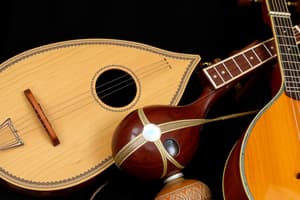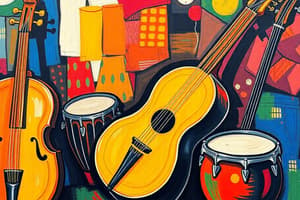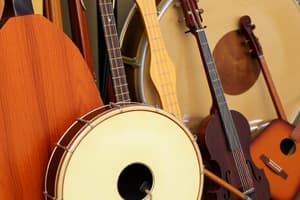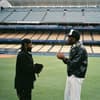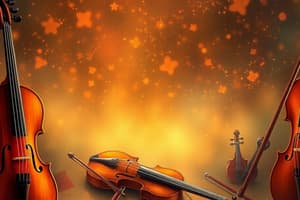Podcast
Questions and Answers
Which characteristic distinguishes Ars Nova from Ars Antiqua in the context of musical notation?
Which characteristic distinguishes Ars Nova from Ars Antiqua in the context of musical notation?
- Ars Nova exclusively used red notes, while Ars Antiqua used black notes.
- Ars Nova introduced the use of bar lines, absent in Ars Antiqua.
- Ars Nova focused on monophonic compositions, unlike the polyphonic Ars Antiqua.
- Ars Nova utilized white notes, while Ars Antiqua employed black notes. (correct)
Which era saw the rise of the Minnesänger in Germany, and what was a key influence on their musical style?
Which era saw the rise of the Minnesänger in Germany, and what was a key influence on their musical style?
- 15th century; influenced by Renaissance madrigals.
- 14th century; influenced by French troubadours.
- 12th century; influenced by Italian opera.
- 13th century; influenced by Gregorian chant. (correct)
The implementation of 4 lines used in musical notation is attributed to which music theorist?
The implementation of 4 lines used in musical notation is attributed to which music theorist?
- Pope Gregory I
- Guido d' Arezzo (correct)
- Saint Ambrosius
- Adam de la Halle
Which of the following is a characteristic of Gregorian chant?
Which of the following is a characteristic of Gregorian chant?
Which historical period is associated with monophonic secular music and dances, with notated examples appearing from the 12th century onward?
Which historical period is associated with monophonic secular music and dances, with notated examples appearing from the 12th century onward?
How did the role of music differ between ancient Rome and the early Christian era?
How did the role of music differ between ancient Rome and the early Christian era?
What distinguishes the misni ordinarij from the misni proprij in a Catholic Mass?
What distinguishes the misni ordinarij from the misni proprij in a Catholic Mass?
Which stringed instrument is characterized by four pairs of strings and is believed to have originated in Italy from the lute, featuring an almond-shaped body?
Which stringed instrument is characterized by four pairs of strings and is believed to have originated in Italy from the lute, featuring an almond-shaped body?
What is the primary function of 'kolofonij' in the context of string instruments?
What is the primary function of 'kolofonij' in the context of string instruments?
Which style period is positioned between the Baroque and Romantic eras, typically characterized by balance, clarity, and formal structure?
Which style period is positioned between the Baroque and Romantic eras, typically characterized by balance, clarity, and formal structure?
Flashcards
Gudaća (String Instruments)
Gudaća (String Instruments)
Instruments that produce sound by vibrating strings. Includes a resonant body, neck, tuning pegs, and strings. All have 4 strings.
Trzaća (Plucked Instruments)
Trzaća (Plucked Instruments)
Instruments where sound is produced by plucking the strings with fingers or a plectrum.
Tambure
Tambure
Traditional musical instruments, plucked instruments. Played with a plectrum.
Limena Puhaća Glazbala (Brass Instruments)
Limena Puhaća Glazbala (Brass Instruments)
Trumpet, horn, trombone, tuba. Instruments made from metal.
Signup and view all the flashcards
Drvena Puhaća Glazbala (Woodwind Instruments)
Drvena Puhaća Glazbala (Woodwind Instruments)
Oboe, clarinet, flute, bassoon. Sound produced by blowing air. Can often sound similar.
Signup and view all the flashcards
Udaraljke s Neodređenom Visinom Tona (Percussion with Indefinite Pitch)
Udaraljke s Neodređenom Visinom Tona (Percussion with Indefinite Pitch)
Bongos, cymbals, gongs, tambourines. Produce sound with indefinite pitch
Signup and view all the flashcards
Udaraljke s Određenom Visinom Tona (Percussion with Definite Pitch)
Udaraljke s Određenom Visinom Tona (Percussion with Definite Pitch)
Marimba, xylophone, bells, chimes, timpani. Produce definite pitches.
Signup and view all the flashcards
Zborska Glazba (Choral Music)
Zborska Glazba (Choral Music)
A style where the melody is sung by 15-30 singers, and they all sing the same note following one line of music
Signup and view all the flashcards
Neume
Neume
Musical notation using symbols to represent musical tones, dating back to the 9th century.
Signup and view all the flashcards
Golijardi
Golijardi
Wandering students. Educated, performed plays and songs in Latin.
Signup and view all the flashcardsStudy Notes
- Notes about music theory and history
Instruments
-
String instruments have a resonant body, scroll, bridge, and strings.
-
All string instruments have four strings.
-
String instruments are the most numerous in the orchestra.
-
Bowed instruments are played with a bow (con arco) or by plucking (pizzicato).
-
Rosin is used on bows.
-
Famous string instrument makers include Stradivari, Guarneri, Amati, and Franjo Kresnik.
-
Plucked instruments produce sound by plucking the strings with fingers or a plectrum.
-
Guitar types include classical, acoustic, electric, and bass guitar.
-
Notable guitarists include Chuck Berry, Elvis Presley, Jimi Hendrix, and Eric Clapton.
-
Harps have 47 strings of different colors and seven pedals.
-
Lutes have a pear shape, a neck at a right angle, and 12-28 strings and originated in the renaissance.
-
Mandolins have four pairs of strings, originated in Italy from the Lute, and have an almond shape (mandola) and are prevalent in Dalmatia and mandolin orchestras.
-
Tambourines are traditional plucked instruments played with a plectrum.
-
Tambourine instruments include Lisernica, brač, lugarija, čelo, and berde.
-
Traditional plucked instruments include Portuguese guitar, ukulele, banjo, and Mexican guitar.
-
Brass wind instruments include trumpet, horn, trombone, and tuba.
-
Woodwind instruments include contrabassoon, bassoon, saxophone, English horn, oboe, clarinet, and piccolo flute.
-
Percussion instruments with indefinite pitch include bongos, congas, large drum, rattle, drum (small drum), cymbals, gong, tambourine, maracas, triangle, castanets, and guiro.
-
Percussion instruments with definite pitch include marimba, xylophone, vibraphone, bells, chimes, celesta, and timpani.
Historical Overview of Musical-Stylistic Periods
- Prehistory, Ancient Age, and Antiquity: up to the 5th century.
- Middle Ages: 5th-15th centuries.
- Renaissance: 15th-16th centuries.
- Baroque: 17th century, first half of the 18th century.
- Classicism: second half of the 18th century.
- Romanticism: 19th century.
- 20th-century and contemporary music.
- Style is the entirety of characteristics by which a creator, period, or artistic type differs from each other.
- Each style has its rise, bloom, and fall.
- It appears first in one art form and is then adopted by other art forms.
Music of Ancient Greece
-
Muses are Thalia, Urania, Clio, Euterpe (goddess of music), Calliope, Melpomene, Polyhymnia, Terpsichore, and Erato.
-
Mousike techne encompasses all arts under the protection of the Muses.
-
The foundation of European culture, philosophy, and science.
-
Instruments associated with Apollo include lyre, kithara, and Dorian scale and with Dionysus include aulos, diaulos, and Phrygian scale.
-
Hydraulus is an early form of the water organ.
-
Choral music involves 15-30 singers performing monophonic singing with instrumental accompaniment.
-
Types of choral songs include dithyramb, threnody, paean, skolion, and hymenaeus.
-
Seikilos epitaph is an example of ancient Greek music.
-
Tragedy involves sung and spoken parts and the writer is the composer (Aeschylus, Sophocles, Euripides).
Rome and Early Christianity
- Music's role: entertainment, performances, gladiator fights, military.
- Music was not considered to be as significant as in Greek culture.
- Rome saw the development of early Christian music, including the singing of psalms and hymns.
- St. Ambrose, Bishop of Milan in the 4th century, composed hymns and transmitted music from East to West.
- St. Cecilia is the patron saint of music declared in the 15th century.
- In 1877, the music magazine "Sveta Cecilija" was founded in Croatia.
- Her day is celebrated on November 22nd.
Monophonic Church Music
-
4th century: Hymns (Himan) feature simple melodies with elements of folk singing and strophic poems in verses.
-
5th-6th centuries: Purification of spiritual melodies from folklore - Pope Gregory the Great devised a unified ritual Antiphonary.
-
Chorale (chant) is performed vocally monophonically, with organs appearing in the 11th century.
-
Free rhythm, scales - modes
-
Melodies: syllabic and melismatic (melisma = ornament).
-
Victimae paschali laudes and Haec dies are examples of hymns.
-
Main church services: Liturgy of the Hours and Mass.
-
Mass is a vocal service in the Catholic Church
-
Ordinary of the mass: Kyrie, Gloria, Credo, Sanctus, Benedictus, Agnus Dei (same text, only the melody changes).
-
Proper of the mass: Introitus, Graduale, Offertorium (text and melody change).
-
Requiem.
-
Gregorian Chant: Monophonic sacred singing of the Catholic Church in Latin, a cappella.
-
Psalmody solo is when the priest/soloist sings alone.
-
Responsorial singing is when the priest and soloists alternate.
-
Antiphonal singing is when two different choirs alternate.
-
Schola cantorum: is a Roman singing school.
-
Veni Creator Spiritus.
Glagolitic Chant and Development of Musical Notation
-
Cyril and Methodius created the Glagolitic alphabet.
-
Glagolitic is to speak in Old Slavonic.
-
Glagolitic chant is the singing of Western Roman Church rites in the Croatian version of Old Slavonic instead of Latin.
-
Krk, Istria, Croatian Littoral, Lika and Dalmatia dating back to the 9th century.
-
Gospode, pomiluj - Dobrinj, Krk.
-
Oral tradition into the 19th and 20th centuries as the first recordings.
-
Accepted by the people and clergy.
-
Some melodies are identical to Gregorian chants, only the text is translated.
-
Heterophonic performance of chants.
-
Puče moj – Kontaduri, Joško Ćaleta.
-
Early Middle Ages: oral tradition
-
Neumes are the first signs used to write down tones, originating in the 9th century.
-
Two phases of neumatic notation: without staff lines and with staff lines
-
Musical theorist Guido d' Arezzo introduced 4 lines and solmization syllables, with neumes written on the staff and text below, including the Hymn to St. John.
-
Gothic notation that began in the 11th century included notes/signs in the shape of a rhombus.
-
Square choral notation from the 13th century noted not only the tone's pitch but also its duration.
-
Tablatures use letters, numbers, and notes, and are still in use today.
-
Anima Christi is an example.
-
Ars antiqua: 13th and early 14th century - development of polyphony, using black notes.
-
Ars nova: 14th century - use of white notes (new art).
Monophonic Secular Music and Dances
-
Notations of secular music date only from the 12th century.
-
Crusades led to the education of knights.
-
Themes of songs include love, satirical, political, heroic, nature, and Crusades.
-
More developed melodies, a wider range, and Old Church scales.
-
Strophic chants: identical melody for each verse.
-
Singing in the vernacular with instrumental accompaniment.
-
Troubadours: Southern France, trobar = to invent, courts (B. de Ventadour)
-
Trouveres: Northern France, Adam de la Halle, courts
-
Minnesanger: Germany, 13th century, influenced by Gregorian chant (Walther von der Vogelweide)
-
Meistersinger: Germany, 15th century, master singers, singing schools (Hans Sachs)
-
Jongleurs: Entertainers, actors, acrobats, and later musicians, performing music in squares and fairs for the people.
-
Vagrants: Wanderers and vagabonds, traveling to European schools, satirical songs against church authorities.
-
Play about Robin and Marion
-
Pastoral is that which portrays pastoral life.
-
Goliards: Poor traveling students, educated, performing skits and songs in Latin.
-
Themes: love, youth, criticism of the church.
Studying That Suits You
Use AI to generate personalized quizzes and flashcards to suit your learning preferences.

